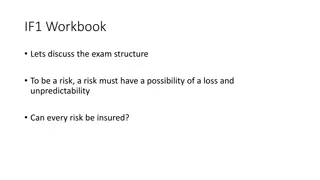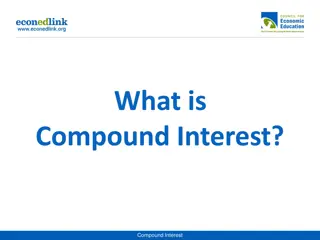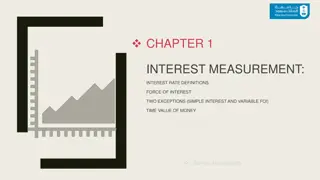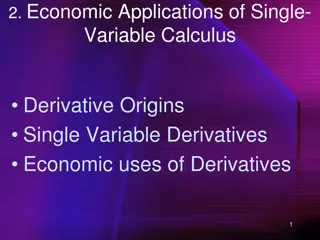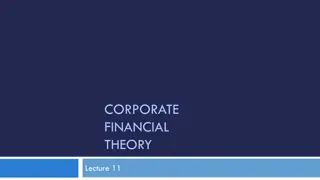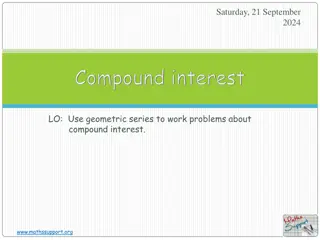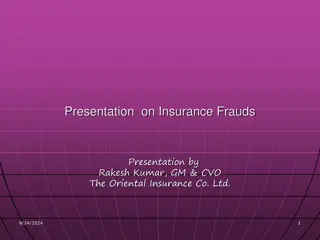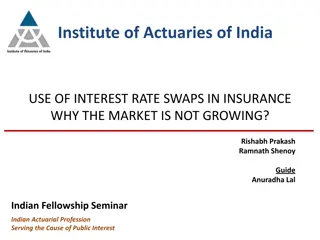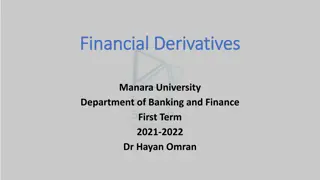Understanding Derivatives for Managing Interest Rate Risks in Indian Insurance Industry
Exploring the use of derivatives in hedging interest rate risks and their significance in the Indian insurance sector. The seminar delves into interest rate risk management, derivatives market dynamics, challenges, and the impact on insurers. Insights are provided on the investment strategies of insurers in the face of varying interest rates.
Download Presentation

Please find below an Image/Link to download the presentation.
The content on the website is provided AS IS for your information and personal use only. It may not be sold, licensed, or shared on other websites without obtaining consent from the author. Download presentation by click this link. If you encounter any issues during the download, it is possible that the publisher has removed the file from their server.
E N D
Presentation Transcript
23rd India Fellowship Seminar USE OF DERIVATIVES IN HEDGING INTEREST RATE RISKS AND ITS RELEVANCE IN INDIAN INSURANCE INDUSTRY Guide Name - ADIT TRIVEDI Presenters Names: Aditya Subhash Bathiya Vijay Arunachalam Mudaliar Vamsidhar Ambatipudi Date : 18-June-2015 Indian Actuarial Profession Serving the Cause of Public Interest
Use of derivatives in hedging interest rate risks and its relevance in Indian Insurance Industry Interest rates and Insurance Industry Overview of Interest Rate Risk Interest Rate Derivatives Conceptual Understanding Interest Rate Derivatives Global Market Interest Rate Derivatives Insurance Industry Interest Rate Derivatives Indian Scenario Key Challenges www.actuariesindia.org 2
Interest rates and Insurance Industry
Insurers Interest Rate Environment Sell long-term products whose present value depends on interest rates Protection from adverse financial consequences Allow customers to save for the future Traditional savings products with built-in guaranteed rates or attached riders that promise a minimum return to the policyholders Challenge - Investing the customers payments to ensure funds are available to satisfy policyholders in the future Life insurers generally invest largely in fixed income securities because most of their liabilities are largely fixed in size Likely impacted by Falling rates(real + Inflation) and tightening spread www.actuariesindia.org 4
Typical Structure of Assets & Liabilities Source: Presentation at Life & Annuity Symposium (SOA) 4th and 5th May 2015 www.actuariesindia.org 5
Bond Allocations - Globally www.actuariesindia.org 6
Interest Rate Risk Insurance Products Risk of Matching assets and liabilities to interest rate sensitivity Values of a life insurer s assets and liabilities change with changing interest rates Matching Fixed Income Investments to the liability profile across all terms is difficult Lack of sufficient availability of longer duration of assets to match the duration of liabilities Reinvestment Risk Credit Risk on Underlying Assets (Default/Downgrade) Liquidity Risk associated with certain investments Behaviour of Policy Holders Contribute more to an annuity with a high guaranteed return when interest rates are low Surrender an annuity with a low return guarantee if interest rates rise significantly Not high for P & C Products Protection Based and Re-priced every year www.actuariesindia.org 8
Ways of Limiting IRR Participating Products Distribution of bonuses can be controlled in case of falling interest rates Guarantees are still exposed Portfolio Immunization (on-balance-sheet technique) Duration Matching and Cash Flow Matching can be done Limited due to unavailability of instruments across all durations Interest Rate Derivatives (Capital Markets) (off-balance-sheet technique) Protect against adverse movement in interest rates Better management of solvency and hence capital Instruments for different maturities can be structured Can help in Tactical Asset Allocation www.actuariesindia.org 9
Risk Management Insurers Business Accept risks on one hand, and manage them on the other Risk pooling and diversification only mitigate but do not eliminate underwriting risk Need to transfer part of the extra risk externally to mitigate capital requirement Reinsurance is a better option for insurance risks (longevity, natural catastrophes, deviation of reserves) Securitization where investors act as a reinsurer conceptually Recourse to derivatives is most common technique for financial risks www.actuariesindia.org 10
IRD for Insurers Liabilities extend up to sixty years in future whereas the financial markets typically do not offer bonds that extend more than thirty years into the future Market for interest rate derivatives has become much more liquid and can be used effectively Combination of investments in bonds of a relatively short maturity and advanced (long term) interest rate derivatives can be used to reduce the risk associated with the liabilities www.actuariesindia.org 11
Reasons for less usage of IRD by Insurers Unfamiliarity with advanced derivatives Conservatism Derivative horror stories in the past Regulatory resistance Lack of adequate focus on financial risk management
Interest Rate Derivatives Conceptual Understanding
Derivative Any instrument or contract that derives its value from another underlying asset, instrument, or contract Over the Counter Forwards Swaps Many types of Options Exchange Traded Futures Some Options www.actuariesindia.org 14
Introduction to IRD Instruments whose payoffs are dependent in some way on the level of interest rates Underlying asset is the right to pay or receive a notional amount of money at a given interest rate Different tools to manage interest rate risk Volume of trading in interest rate derivatives in both the over-the-counter and exchange-traded markets has been increasing rapidly Popular for investors with customized cash-flow needs or specific views on the interest rate movements www.actuariesindia.org 15
Types of Interest Rate Derivatives Forward Rate Agreement -Agreement to purchase or sell a specified quantity of interest bearing security for an agreed price with delivery and settlement at a specified future date Customized, No MtM, No guarantee of Performance Interest Rate Futures Agreement to buy or sell a fixed interest instrument at a specified future date for a price agreed today Short Term Eurodollar, Treasury Bills Long Term Treasury Bond & Notes Forwards Interest Rate Derivatives - Vanilla Futures Swaps Caps, Floors and Collars- Agreement that gives right but not an obligation to buy or sell a specified fixed interest instrument at a fixed price within specified time Cap Upper Limit on Rates Floor Lower Limit on Rates Collar Buy Cap and Sell Floor Options Interest Rate Swaps Agreement between two parties to exchange floating interest payments for fixed interest payments on a specified notional amount for a specified period Basis Swap Both Legs floating rates www.actuariesindia.org 16
Other Types of IRD Entitles the holder to receive a coupon at maturity for each day that a specified rate remains within an agreed-upon range. Used by holders with exposure to floating rates Gives the right, not obligation, to enter into a swap in future Holder gets protection against the default of a Reference Entity In the CDS market, buying protection means reducing credit risk, and selling protection means assuming credit risk Swaptions CDS and Other Credit Derivatives Corridor Option Non Traditional Derivatives Constant Maturity swap/note/bond Inverse Floater Other Floaters Medium or Long term rate is used instead of LIBOR for floating leg Bond that pays a coupon that varies with changes in the rate Range Coupon that depends on number of days the underlying rate is in a range Ratchet Floating interest rate Increase or decrease relative to previous coupon Inflation Linked Fixed Coupon linked to inflation index Callable and Puttable Bonds www.actuariesindia.org 17
Key Risks Addressed by IRD Actuarial Risk Market Risk Meeting Guaranteed rates to policy holders in case of falling rates and Duration of Assets < Duration of Liabilities Fixed Receiver Swaption can be used to mitigate (Pay Float and Receive fixed during falling rates) Guard against massive potential losses resulting from a major natural disaster (Catastrophe Swap Pay Fixed Receive based on Catastrophe Index) Mismatching of Assets and Liabilities Gap Risk Duration matching is difficult because of high volatility Interest Rate Futures/Swaps can convert Fixed to Floating and vice versa and reduce volatility of Balance sheet Volatility Swap, Correlation Swap , Constant Maturity swap also serve the purpose Risks Addressed Credit Risk Liquidity Risk Forced Selling of assets to meet surrenders Entering into FRA or IR Options with large banks as counterparties enable to adjust their liquidity holdings to an upcoming liquidity Widening Bid offer spreads can be reduced Withdrawal option: A put of the illiquid underlying at the market price Return Swap, Return Swaption, Liquidity Option can address liquidity risk Credit Derivatives like CDS enable investment in having exposure to different types of Fixed Income Securities Credit Default Swap, Total Returns Swap and Credit Linked notes address the exposure to interest rates and hence the default risk www.actuariesindia.org 18
Interest Rate Derivatives Global Market
A Glance of Global OTC Derivatives Market www.actuariesindia.org 20
A Glance of Global IRD Market www.actuariesindia.org 21
Interest Rate Derivatives Insurance Industry
Insurance Industry and Derivatives Exposure is less than 1% of total cash and invested assets as per NAIC 2013 Report Notional amount of derivatives exposure is increasing year over year Use derivatives to implement various investment and portfolio strategies, such as hedging, Lower the funding costs, replicating assets and generating income www.actuariesindia.org 23
Commonly used Derivatives Derivatives play a significant role in insurer risk management practices and implement the overall asset-liability management strategies Long-dated interest rate swaps to increase the interest rate duration of assets Credit default swaps to synthetically replicate investments that are otherwise more expensive or unavailable CDS to hedge existing credit exposures where uneconomical to sell the existing related asset Equity options to reduce market risks associated with certain policies, and financial guaranty contracts Derivatives to earn additional investment income - sell covered call options (Speculative Positions) Replicate illiquid securities by selling credit protection on a corporate name through a credit default swap while buying a liquid government security www.actuariesindia.org 24
Insurers use Derivatives for Efficient portfolio management (Grow Asset Portfolio Faster and have diverse risk profiles) Reduce Investment Risk Tactical Asset Allocation Tax Management Hedging Specific Liabilities Products with Embedded Options With profit guarantees Improving returns Creating Synthetic Assets Floating rate Bond = Fixed Rate Bond + Interest rate Swap Pay Fixed IRS = Long Floating rate Bond + Short Fixed rate Bond Exploiting investment opportunities Solvency management Substitute risk management (Inexpensive) for capital (Expensive) Equity Put option to reduce falling equity value Solvency Protection against adverse Interest rate movement www.actuariesindia.org 25
Using Interest Rate Derivatives Examples Existing Fixed Rate Liabilities Risk Exposure to variability in future value Hedging Strategy Convert Interest paid to floating by entering into IRS Asset Lock in a minimum value by buying a put option or buying a Payer Swaption Liability Lock in a Maximum Value by buying a call option or a Receiver Swaption www.actuariesindia.org 26
Using Interest Rate Derivatives Examples Commitment towards Fixed rate Liabilities Risk Exposure to variability in interest rate payments due to changes in Interest Rate Hedging Strategy Pay Fixed Receive Floating IRS (Lock in the future rate) Buy a Cap or enter into a collar (Upper limit on future interest to be paid) Participate in declines of interest rate by buying a payer swaption or a put option on a Bond Floating Rate Liabilities Risk Exposure to variability in interest rate payments Hedging Strategy Convert the Interest paid to fixed by entering into Interest rate swap Buy a Cap or enter into a collar (Upper limit on future interest to be paid) www.actuariesindia.org 27
Interest Rate Derivatives Indian Scenario
Interest rate risk in India Increasing Long term Debt issuance by Government Higher IRR Cost efficient hedging mechanism is needed Volatility of interest rates increased manifold in the last few years Greater convergence of Indian economy with global markets increases more drivers for interest rate risk www.actuariesindia.org 29
Interest rate OTC Derivatives Trade volume IRS Trade Summary (Rs. in bn) Total Notion al Amnt MIBOR MIFOR INBMK Period Notional Amnt 47,281 87.72% 26,448 91.99% 14,521 96.10% 23,597 96.58% 24,510 95.67% 20,216 96.37% Notional Amnt 6,476 12.01% 2,237 7.78% Notional Amnt Trades Trades Trades Trades 79495 81.10% 40912 89.24% 20,352 94.75% 33,057 95.82% 33,642 94.09% 22,713 94.73% 18139 18.51% 4,799 10.47% 1,050 4.89% 1,291 3.74% 2,101 5.88% 1,252 5.22% 385 144 2007-08 98019 53,901 0.39% 132 0.29% 0.27% 66 2008-09 45843 28,751 0.23% 539 77 51 2009-10 21479 15,111 3.56% 749 3.07% 1,100 4.29% 754 3.60% 0.36% 150 0.43% 0.34% 88 2010-11 34498 24,434 0.36% 14 9 2011-12 35757 25,619 0.04% 0.03% 11 6 2012-13 23976 20,977 0.05% 0.03% www.actuariesindia.org 30
Interest Rate Futures Fundamental Risk management tool for financial markets worldwide Global market turnover is around $1000 trillion (10 times that of equity index futures) Future contract based on 8.4% GOI Securities with maturity on July-2024 Future contract based on 7.72% GOI Securities with maturity on May-2025 Insurance companies can use for Hedging, Changing duration of their portfolio and lock-in of yield www.actuariesindia.org 31
Pros and Cons Interest Rate Futures Advantages 10 Year G-Sec is the underlying Most Liquid Good to hedge Long duration non participating liabilities Less Basis Risk Cash Markets closely Mirrored No counterparty default risk Disadvantages Possibility of Rollover risk Less Liquidity beyond 1 month Basis Risk Change of Benchmark Cannot offer a good hedge for all maturities Volumes yet to gain sufficient traction www.actuariesindia.org 32
Pros and Cons Interest Rate Swaps Advantages Customized as per ones requirement Fairly Liquid market Better duration matching and reducing reinvestment risk thus enhancing portfolio returns Disadvantages Basis risk if the spread between G-sec and OIS is wider Require close monitoring of credit risk and interest rate risk Liquidity only up-to 5 year period exists Counterparty risk Volumes declining over last few years www.actuariesindia.org 33
Interest Rate Derivatives for Indian Insurance Industry IRF was introduced by RBI first time in 2003 and again in 2011 but failed Re-launched on 21st Jan 2014 on both NSE and BSE (Cash settled and no physical delivery is required) IRDA Guidelines 2004 Permitted use of derivatives with a maximum tenure of 1 year to hedge the interest rate risk on investments and forecasted transactions Not suitable for Insurers New Guidelines 2014 Allowed to hedge reinvestment of maturity proceeds, investment of coupon payment receivable and expected future premiums on existing business already written beyond 1 year While dealing in FRAs and IRS, insurers have to ensure that their counter parties are either commercial banks or primary dealers only Disclose the details of their hedging strategy, accounting policy and nature of outstanding interest rate derivatives in their financial statements www.actuariesindia.org 34
Interest Rate Derivatives for Indian Insurance Industry Banks are the major players on Short side of IRS (Duration of assets is longer and for liabilities is shorter) Life insurance companies can go long on IRF to hedge the interest rate risk thus creating good liquidity IRS can now be used to match liability profile more closely and at nominal cost More insurance companies participation in IRS will augur well for better price discovery and reduce arbitrage opportunity www.actuariesindia.org 35
Recent Advances - Interest Rate Derivatives market Consider an electronic Swap Execution Facility (electronic trading platform) for the IRS market Consider introducing a CCP for providing guaranteed settlement of trades executed through the electronic platform Standardize IRS contracts to facilitate centralized clearing and settlement of these contracts Insurance companies and mutual funds permitted to participate as users in CDS Market www.actuariesindia.org 36
Few essential aspects for insurers Reliable measures for potential exposure are needed Closing out the positions should not be difficult Marketability Independent verification of pricing Credit worthiness of the counterparty Admissibility of underlying assets for solvency Cap on Potential of Losses in comparison to investment Amount of Leverage to be taken Covered vs. Naked Derivatives www.actuariesindia.org 38
Challenges/Issues to Indian Insurers Managing derivatives for hedging purpose is complicated process Ensuring detailed Risk management policy in place Board approved derivative policy with adequate understanding of the risks associated Robust IT management systems, experienced staff Suitable risk limits and effective monitoring of risk limits Measuring and demonstrating hedge effectiveness Compliance to hedge accounting Regulatory reporting on derivatives position along with counterparty exposures www.actuariesindia.org 39
Challenges regarding IRD Robust procedures for pricing and hedging these products More difficult to value than equity and foreign exchange derivatives Behaviour of an individual interest rate is more complicated than that of a stock price or an exchange rate Necessary to develop a model describing the behaviour of the entire zero-coupon yield curve Volatilities of different points on the yield curve are different Interest rates are used for discounting the derivative as well as defining its payoff www.actuariesindia.org 40
Question Time www.actuariesindia.org 41
Bond Options Option to buy or sell a particular bond by a particular date for a particular price Embedded in bonds - More attractive to the issuer or potential purchasers Callable Bond Issuing firm can buy back the bond at a predetermined price at certain times in the future Strike Price Predetermined price that must be paid by the issuer to the holder Lock-in Period for the first few years of their life Decreasing price with time Bonds with call features generally offer higher yields than bonds with no call features Puttable Bond Allow the holder to demand early redemption at a predetermined price at certain times in the future Increases the value of the bond to the holder Lower yields than bonds with no put features Prepayment privileges on loans and mortgages are similarly call options on bonds www.actuariesindia.org 43
Caps, Floors and Collars Interest rate cap Provide insurance against the rate of interest on the floating-rate note rising above a certain level (Cap Rate) Tenure, Life of the cap and Cap rate need to be defined Portfolio of call options on interest rates (Caplets) or a portfolio of put options on zero-coupon bonds Floors Payoff when the interest rate on the underlying floating-rate note falls below a certain rate Portfolio of put options on interest rates or a portfolio of call options on zero-coupon bonds Collar Instrument designed to guarantee that the interest rate on the underlying LIBOR floating-rate note always lies between two levels Combination of a long position in a cap and a short position in a floor Constructed so that the price of the cap is initially equal to the price of the floor (Zero Priced Collar) Value of cap = Value of floor + Value of swap (Same Strike Rate) www.actuariesindia.org 44
Swaptions Options on interest rate swaps Give the holder the right to enter into a certain interest rate swap at a certain time in the future Provide companies with a guarantee that the fixed rate of interest they will pay on a loan at some future time will not exceed some level Regarded as an option to exchange a fixed-rate bond for the principal amount of the swap Company is able to benefit from favourable interest rate movements while acquiring protection from unfavourable interest rate movements Alternative to Deferred/Forward Swaps Involve no up-front cost but have the disadvantage of obligating the company to enter into a swap agreement www.actuariesindia.org 45







